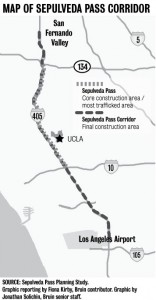
The Los Angeles County Metropolitan Transportation Authority has started the process of creating a construction plan to alleviate traffic between the San Fernando Valley and Los Angeles International Airport along Interstate 405, which runs past UCLA.
In a recent study on the Sepulveda Pass Corridor, a stretch of the I-405 between the San Fernando Valley and Los Angeles International Airport, Metro found that about 50 percent of traffic comes from the Sepulveda Pass, a 10-mile leg in the middle of the corridor that runs near UCLA between the U.S. 101 and Interstate 10.
UCLA Transportation estimates there are about 5,000 students who commute through the Sepulveda Pass, said David Karwaski, UCLA Transportation planning and policy manager.
On Jan. 2, the Metro presented six different ideas to lessen the traffic in the Sepulveda Pass Corridor to San Fernando Valley residents at their board meeting.
Metro has proposed constructing a 30-mile shoulder for buses during peak traffic hours, five new express lanes or a 10-mile-long elevated highway coupled with four different express lanes.
Metro also presented plans for a possible tolled nine-mile highway tunnel, a 28-mile rail tunnel or a 21-mile highway and private rail tunnel as options for easing the flow of traffic in the Sepulveda Pass Corridor.
Metro intends to select and expand on one plan by the end of next year, said Roger Moliere, chief of real property management and development for Metro.
Jesse Pantoja, a second-year biology student, commuted to UCLA from Southgate over the summer. His 23-mile commute, a 20-minute drive at non-peak hours, included the Sepulveda Pass and took him around an hour in the morning because of traffic, he said.
Karwaski said UCLA Transportation officials support Metro’s plans for construction in the Sepulveda Pass Corridor.
Anything to lessen traffic in the Sepulveda Pass area would be beneficial to commuting members of the UCLA community, Karwaski said.
“We look forward to seeing connections between San Fernando Valley and UCLA. We certainly need it, and it will be beneficial,” he said.
Moliere said Metro is focusing on improving traffic in the Sepulveda Pass Corridor because the project will not take money away from other plans and is intended to help a regularly congested area.
According to the Sepulveda Pass Corridor Systems Planning Study, construction costs of the full Sepulveda Pass Corridor project range from $162 million to $30.75 billion.
The project will be funded by Measure R, a 2008 Los Angeles County measure for new transportation projects that alloted $1 billion to the Sepulveda Pass Corridor using tax revenue.
But because that funding would not come through until 2039, said Dave Sotero, a spokesman for the Los Angeles County Metropolitan Transportation Authority, the next logical step would be to ask private industry groups to help fund the project through a Public-Private Partnership, which uses funds from the private industry for projects undertaken by Los Angeles County.
Pantoja said that as long as the funding was there, he would support construction to alleviate traffic in the Sepulveda Pass Corridor.
“(With less traffic) I would get more sleep, which is definitely a luxury,” he said.
Moliere said the next step is to define the construction project more completely. He said the combination highway and rail tunnel seems to be the most promising, though none of the proposals are set in stone.
He added that they hope to start looking for investors next year and expect to start construction at least three years after funding has been secured.
Email Flona at fkirby@media.ucla.edu.